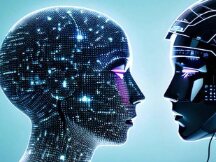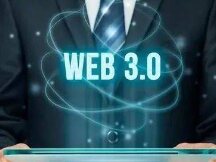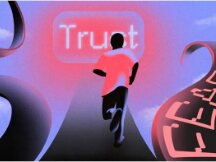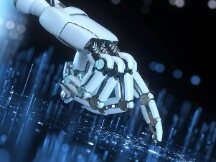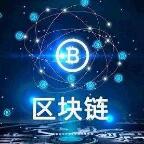An Analysis of the Development and Timeline of Web 3.0, Is the Internet the Next Generation?
Web3.0 is considered to be the next generation of the Internet which will undergo significant changes and modifications to current business models. Over the past year, the concept of Web3.0 has grown in popularity around the world with "viral" speed.
According to data from Google Trends, Web3.0 and other searches have increased.

Figure 1: Check out the differences for Web3 over the past year (Source: Google Trends)
Although the concept of Web3.0 is not the same, it is often compared to Web2. In Web2, the platform acts as an intermediary to control user data and content, and there is a risk of data deletion. In addition, data on the platform cannot be shared, and users may also be subject to moderate censorship and restrictions.
Web3.0 is the solution to these problems. The main idea of Web3.0 is to return ownership of data to users, to enable users to manage their personal information, and to complement data interaction with the principle of security. At the same time, users don't have to worry about average censorship.
I. Web 3.0 infrastructure
a) Blockchain and cross-chain technology
The name Web3.0 came before the blockchain. However, before the advent of blockchain, Web 3.0 was only at a critical stage due to the lack of solutions. With the advancement of blockchain technology and the rise of cryptocurrency traders, more Web3.0 related activity has taken place in the blockchain ecosystem like Ethereum and Polkadot. As a result, blockchain technology laid the foundation for improving Web3.0.
As all blockchain industries are concerned, the integration of several chains will continue for a long time to come. In this case, Web3.0 users from many different blockchain ecosystems should be involved, and cross-chain technology plays an important role in this process.
Currently, key technologies include automatic machines, side chains or fittings, time locks, self-regulation, etc.
b) Decentralized identity
Decentralized Identity (DID) is an integral part of the entire Web3.0 architecture. DID follows the basic concept of Web3.0, allowing users to own and manage their numeric characters. DID contains user and personal information, so it can only be used with user rights and has features such as security, authentication and interoperability. The DID system recognizes self-discovery, identification and identification in a distributed and unreliable manner based on identification and authorization on a personal basis.
c) Distribute
Web3.0 is committed to changing the management of data from the root platform, and from this point of view, the Web3.0 project does not store data on the root server. Therefore, the Web3.0 project contains a large amount of data that needs to be stored and partitioning is important in the development process.
Compared to traditional centralized storage, distributed storage has the advantages of high security, privacy and protection against any malfunction. However, in practical terms, exports face the risk of mistrust, user experience, and regulatory requirements. Currently, large decentralized storage projects include Filecoin and Arweave.
d) Self-calculation
In Web2, the business model of the middle platform is usually to get traffic and revenue from user data. Web3.0 also includes the use and analysis of data.
However, it is necessary to supplement the calculation with a self-assessment of where user data and privacy are recognized in determining information security and privacy. Multiparty Computing Security is a solution for using personal computers that can recognize shared interactions while protecting the privacy of two parties who do not trust each other.
ii. Advantages and limitations of Web3.0
Web3.0 can be seen as a combination of Web2 and the defined process, and Web3.0 can be seen as a modification of Web2 through key concepts and procedures.
A good
Web3.0 projects are still distributed and distributed, and are not affected by a failure. Even if a particular part of the system is disconnected from the network, other nodes can still complete the data transfer and conversion rate, and the whole system is not affected.
In Web2, the middle platform benefits from user data, but does not distribute revenue to users. Web3.0 users manage their own data ownership, helping to achieve data balance. The Web3.0 project can provide the necessary support and the users can benefit from their involvement in the development of the project.
Web3.0 offers better interaction and mobility. The Web3.0 project can complete ecosystem integration, eliminating data island and platform issues. Based on the information technology received by the user, the user can provide social data based on real world situations to achieve ecosystem integration. At the same time, users have access and access to their data, and Web3.0 can better protect user privacy.
b) restrictions
First, the Web3.0 project was designed from the blockchain, and the performance of the chain limits the development of the Web3.0 project. From the perspective of previous blockchain projects, improving security by reducing user experience not seen by users. Compared to mid-range platforms, we don't think blockchain TPS is appropriate for application scenarios that currently require low latency.
second,Relationships and other aspects of Web3.0 projects have a strong impact on the network. In other words, some users have to write to the whole ecosystem to improve the size. The cost of using blockchain and process algorithms is high, and initial user training is very high. As a result, many users will be denied access to the blockchain ecosystem and use of the Web3.0 project will be restricted. Therefore, in order to get more users to participate and implement the Web3.0 project, we need to find a better balance between user experience and security.
third, each blockchain ecosystem has a different DID system, which not only chooses the technology, but also the sharing of the benefits among the participants. Different DID processes have different models and different authentication processes. This can disrupt data sharing, making data and data islands non-conforming to the concept of Web3.0.
Fourth,The basic concept of Web3.0 makes significant progress in protecting user privacy, but at the same time, it is difficult to maintain. In the future, Web3.0 projects may be affected and limited by regulations. Because admins won't endorse a completely censorship-resistant platform.
iii. Conditions Web 3.0
The best time to invest is to participate in the development of Web3.0. Whatever Web3.0 project stands out, everything needs process support. Improvements are still possible in the areas of public channels, cross chains, identification procedures, distribution and counting of personal information.
For example, a Web3.0 blockchain hosting project should be more efficient and robust, and the cost of using distributed plans should be low enough and not be different from the user experience of cloud storage.
In addition to hardware development, the development and investment of Web3.0 are as follows.
a) Identification of data in strings
Data authentication can change the business model of blockchain operations, and in the process, technologies such as DID and personal data counting will play an important role in personal protection.
As the number of blockchain users increases, the value of data on the chain has increased exponentially. This information plays an important role in identifying user images.
By properly analyzing the data, data such as string scores can be obtained and various demands can be extended. Take the example of the DeFi project. Many DeFi programs now use loans instead of loans, and low spending is still an issue that plagues many DeFi operations.
After the data entered into the chain, the data can be entered into the chain based on historical data, Web3.0 system can provide data analysis and aggregation of user information such as ID, credit, user photos, etc., etc. to. The use of unsecured loans or mortgages for consumers with high credit improves the use of efficient credit.
b) personal information of the supplier
In theory, Web3.0 eliminates the need for multiple groups of DID systems. However, for many reasons, the DID system is different for every blockchain ecosystem, and DID integration is not going to happen in the short term.
In this case, the ID integration project, which requires similarity and integration with most DID models, will be very convenient for users. The Identifier Aggregation Project supports the integration of user DID credentials across multiple ecosystems, enabling users to view, manage, and compile credentials across multiple network blockchains . At the same time, the project aggregation itself can expand its role by integrating project measurement data, project application, etc.
C) Personal information protects technological development
Currently, users are not paying enough for information like tokens and blockchain funds. They are leaving more and more public information on the channel and pose a security risk because anyone can access it without authorization.
In Web3.0, information and privacy knowledge will be stronger, users do not want to sacrifice themselves more easily, the current standard refers to Web3.0 application for privacy, can not be satisfied. Especially after the rise of DeFi, many users did not want others to monitor their business on the chain.
Privacy enhancement technology can solve the problem of privacy and confidentiality of data changes and prevent users from receiving the data changes. Privacy enhancing technology enables the secure sharing, collection and review of information without compromising security and privacy.
d) Web2 and Web3.0 support
Currently, many users still focus on the rooted platforms and are locked into these platforms to develop user behavior. Intermediaries can act as a bridge to help users migrate from Web2 to Web3.0. The implementation of tools on the Web2 platform allows users to send encrypted data and digital results through a known platform, thus reducing the initial need for users of the Web3.0 project.
ib iv. project officer
A) Attend the meeting
Chat is a blockchain-based Web3.0 project that combines features such as wallet, digital personalization, personalized chat, and the NFT design platform, allowing users to control their data and ensure the security of users. data. Users communicate through Comingchat, and the platform or other users do not steal data and information, thus avoiding the risk of seeing users' personal data and information. At the same time, users can trade digital assets through ComeChat.
b) RSS 3
RSS3 is a web3.0-based social enterprise that eliminates the need for information and content for users by creating new content in a social and collaborative environment that combines various models and allows participants to master the content of the mission . .
As an open ecosystem, RSS3 is designed to provide a wide range of extension models and developers can create other models for the system without permission. To support multi-purpose applications, the RSS3 team has developed several intermediate feeds that can be built on top of RSS3, which will unlock huge potential for generating impactful internet content.
From Ethereum to Instagram, from NFT to Tweets, RSS3 aims to provide the metrics to deliver the network. RSS3 allows users to create their own social networks by creating their own social graphics. RSS3 aggregates the network into user metrics, allowing users to further configure the data.

Daim duab 2: Architecture diagram RSS3 (Data source: RSS3 DECK)
C) Web3.0Go
Web3.0Go provides a suite of data services integrated with Web3.0 and provides the necessary framework for a wide range of applications in the Polkadot ecosystem. Web3.0Go services typically include asset swapping, parachain hosting, and DeFi functionality monitoring and visualization.
As a data analysis project, Web3.0Go can complement location display, create user portraits based on the behavior of data on the channel, list user ID databases, and combination with other functions to use. The rewards on Web3.0Go are always smart contracts to encourage users to post business data and view data.
Web3.0Go can process and query data in its data query module and can provide customized data representation for specific situations. By using the Web3.0Go interface and writing SQL code, users can create community graphics and ads for members to use. Behind this lies the idea of data equivalence and cost sharing, allowing all users to understand the huge potential behind using blockchain data through simple manipulations.

Figure 3: Architecture diagram of Web3.0Go (file source: Web3.0Go DECK)
v. Contents
The middle platform brings convenience to people, but it also has a lot of issues. Today, the growing power of Web3.0 has attracted a lot of people, and some companies, including Twitter and Reddit, are looking for ways to integrate the Web3.0 concept into the platform. They explore and learn from the founders' perspective of business inspiration, self-improvement in the medium and buy-in to information and content to shape the future of entrepreneurship on distributed platforms. .
Going forward, Web3.0 will provide users with differentiated functionality, which will change the way users interact and interact with the Internet, and the rise of DAOs will not continue to play a significant role recently.

Scan QR code with WeChat


